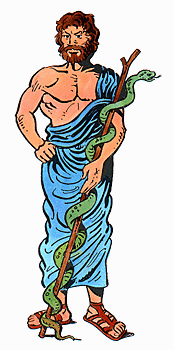Aesculepius, Asculapius (Latin); Asclepius, Asklepios (Greek), Part 1 of 2 +
(A god for all medical doctors)
First, he was a Greek mortal
Who was this Greek "god" Asclepius or Asklepios [es KLEE pi uhs] which was changed in Latin to Asculapius or Aesculapius [es" kyoo LAY pee uhs]?
His name may not be as well-known as that of Hermes, but we know that the Romans showed high regard for him by setting aside Januarius 1 as a special day to remember him in worship.
Perhaps this date is set aside because it is believed to be when his temple was established Januarius 1, A.U.C. 463 (January 1, 291 B.C.) on Tiber Island (Insula Tiberina) to teach medicine in Rome.
The cult apparently was established to eradicate a plague that was in the city. Even today, St. Bartolomeo, a hospital, is located on the island thus continuing the healing arts established there so many centuries before.
Born on the funeral pyre as his mother was about to be cremated
When Homer, the author of the Iliad and the Odyssey, wrote about Aesculapius, he was portrayed as a mortal, and it appears that his primary distinction was that he was the father of two doctors in the Greek army.
Four centuries later, Aesculapius had become one of Greece's most important gods. Socrates' last recorded utterance as the hemlock started to take hold was to remind Crito that they owed Aesculapius a rooster sacrifice.
Apollo (also a god of healing) was said to be his father and his mother was Coronis. Although Apollo loved Coronis, she preferred a mortal and foolishly thought that Apollo wouldn't find out about her adultery.
Just before she was to be burned on her funeral pyre, after being killed for her infidelity, Apollo is supposed to have "snatched away the baby which was very near birth" and took him to Chiron, the wise and kindly old Centaur, to bring up in his cave on Mt. Pelion.
The history of medicine is a story of amazing foolishness and amazing intelligence.
The child was named Asklepios (Asclepios), and Chiron passed on his considerable knowledge in the use of herbs and gentle incantations as well as cooling potions to this boy who showed an unusual enthusiasm for learning.
Aesculapius not only learned what Chiron taught him, but he was credited with treating whoever came to him whether from wounds or bodies wasting away with disease, "even those who were sick unto death, he delivered from their torment."

His medical miracles were too much for the gods
Legend proclaims that Aesculapius, as a mortal, had cured so many people, Pluto complained that hades was becoming under populated and complained to Zeus.
Disturbed by the physician's daring to tamper with the laws of life and death, Zeus used a thunderbolt to "dispatch Aesculapius into hades."
One source says that later he was brought into the family of gods. Others say that despite the displeasure of the King of Gods and Men, he was honored on earth as no other mortal. This was shown for hundreds of years after his death as the sick and the maimed and the blind went to his temples for healing.
They would pray and sacrifice, and then go to sleep. In their dreams, the good physician would reveal how they could be cured or gave them immediate treatment.
Apparently, according to temple records, thousands upon thousands of sick people through out the centuries believed that he had freed them from their pain and restored them to health.
Aesculapius is said to have had two sons, Podaleinius and Machaon, both surgeons; and three daughters, Hygeia (Health), Iaso (Healing), and Panacea (Cure-All).
The only "child" of importance in story, or cult worship, was Hygeia whose cults were both associated with and which also existed independently of Aesculapius.
Aesculapius may have established the first "hospitals" and "health spas"
The temples of Aesculapius were more than places for his cult-worship which was widespread throughout Greece. They were places of healing and so they may be considered prototypes of modern hospitals.
The most celebrated of his healing temples were located at Cos, Epidaurus, Cnidus, and Pergamos. These temples flourished during the time of Hippocrates (late 5th century B.C.) but they existed independently of his school.
In the Asclepia (Asklepia) [es KLEE pee uh] temples, the priests of the cult applied their secret knowledge as well as religious rites to bring about their cures.
Treatment was free, although patients who could afford it were expected to contribute to the cost of running the temples.
At its peak of popularity, the cult appeared by some to represent the most successful attempt, historically, to fuse religion, magic, hypnotherapy (suggestion), and nature cure (diet, rest, massage, and hydrotherapy) into the services of healing.
The most famous temple was located in the ancient seaport of Epidaurus. "Access to the shrine was forbidden to the unclean and the impure, pregnant women, and the mortally afflicted were kept away; no dead body could find a resting place within the holy precincts, the shelter and the care of the sick being undertaken by the keepers of inns and boarding-houses in the neighborhood.
The suppliants for aid had to submit to careful purification; to bathe in sea, river, or spring; to fast for a prescribed time; to abjure wine and certain articles of diet; and they were only permitted to enter the temple when they were adequately prepared by cleansing inunction [an act of applying oil or ointment] and fumigation [the application of smoke, or other vapor, for cleansing purposes].
This lengthy and exhausting preparation, partly dietetic, partly suggestive, was accompanied by a solemn service of prayer and sacrifice [especially of a rooster], whose symbolism tended highly to excite the imagination."
Nature, time, and patience are the three great physicians.
![]() Aesculapius, Part 2 of 2.
Aesculapius, Part 2 of 2.
![]() The caduceus and symbolism.
The caduceus and symbolism.
